por ISKCON desire tree
Appearance of Lord Nityananda ISKCON San Diego 2010
Appearance of Lord Nityananda ISKCON San Diego 2010
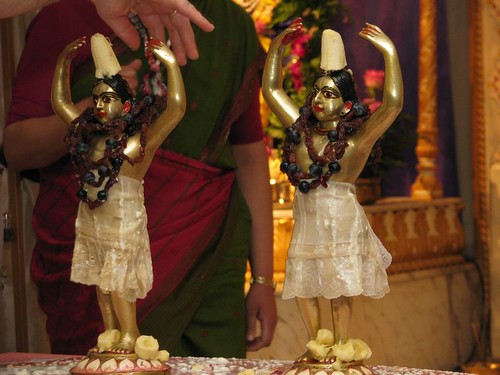
Appearance of Lord Nityananda ISKCON San Diego 2010

Appearance of Lord Nityananda ISKCON San Diego 2010
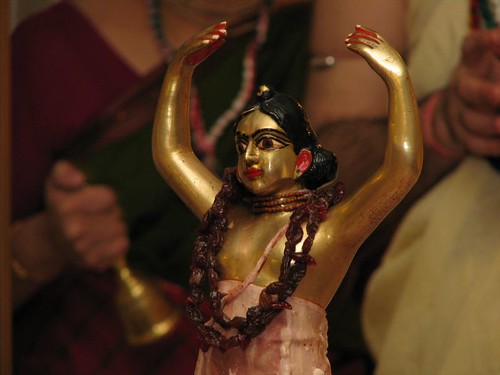
Appearance of Lord Nityananda ISKCON San Diego 2010
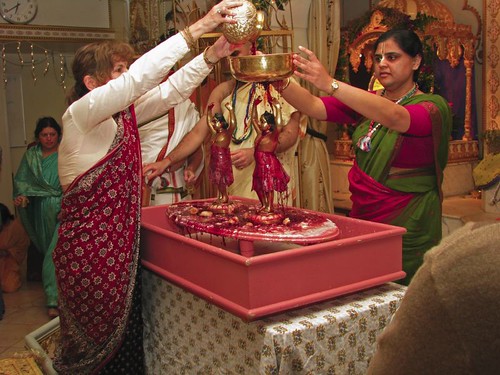
Appearance of Lord Nityananda ISKCON San Diego 2010
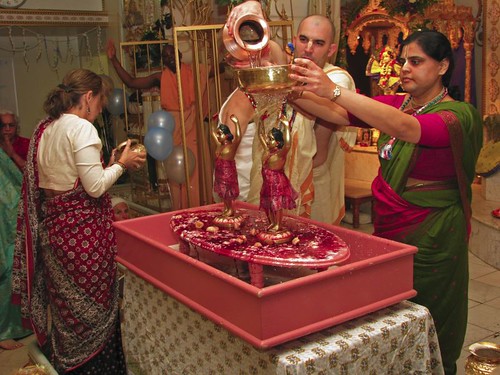
Appearance of Lord Nityananda ISKCON San Diego 2010
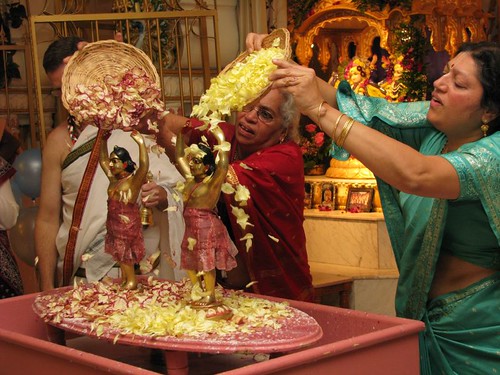
Appearance of Lord Nityananda ISKCON San Diego 2010
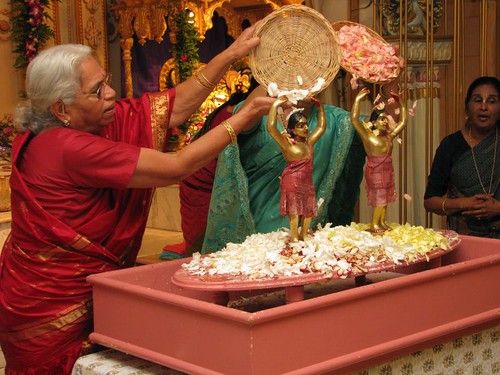
Appearance of Lord Nityananda ISKCON San Diego 2010
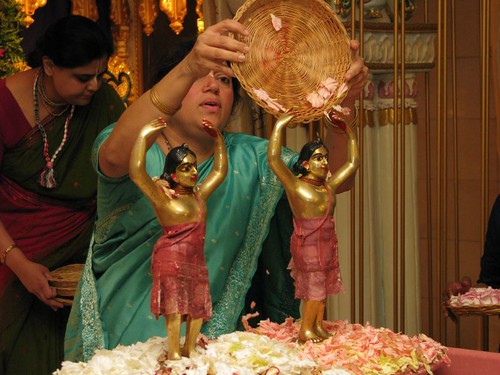
Appearance of Lord Nityananda ISKCON San Diego 2010
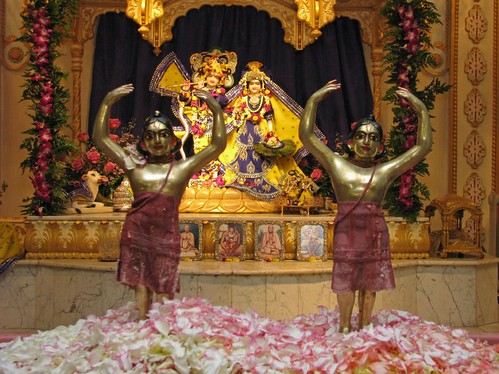
Special Radha-katha, de Sri Srimad Gour Govinda Swami
EXTERNALLY TWO, INTERNALLY ONE
Sri Srimad Gour Govinda Swami Maharaja
There is no difference between Radha and Krishna, sakti-saktiman-abhinna. There is no difference between sakti, the energy, and saktiman, the energetic. radha-krsna aiche sada eka-i svarupa lila-rasa asvadite — In order to relish the sweet mellows of these pastimes of conjugal love there are two forms, two bodies. Ramana means enjoyer, and ramani means enjoyed. Krishna is ramana, and Radharani is ramani. Radha and Krishna are two persons with two bodies. That is a fact. There is bhinnatvam, difference, in the sense of them being sakti and saktiman, the energy and the energetic source, but there also is abhinnatvam, non-difference, in the sense of their moods. The difference is in visaya and asraya. Krishna is visaya-alambana and Radha is asraya-alambana — Radha is the abode of love, whereas Krishna is the object of love. But although there is difference, there is also non-difference between them. Radha and Krishna in two bodies is acintya-bhedabheda tattva, simultaneous difference and non-difference. Krishna is srngara-rasaraja-murti — the embodiment of srngara-rasa — and Radharani is the embodiment of madanakhya-mahabhava. To relish mellow there are also two types, asraya-alambana, and visaya-alambana. Radharani is asraya-alambana, the abode of love, whereas Krishna is visaya-alambana, the object of love.
Srngara-rasaraja-purna-bra
So it is neither correct to say that there is complete difference nor would it be correct to say that there is complete non-difference. There is simultaneous difference and non-difference, and this is acintya, inconceivable. They are acintya-bhedabheda — simultaneously one and different.
As long as there is a difference of mood then the relishing of mellow will not be complete. When it comes to the stage of non-difference, oneness, then the relishing of mellow is complete — visrambha mananam. Visrambha means oneness. Therefore this verse says, “pranaya-vikrtir” not “prema-vikrtir”.
In Jiva Goswami’s Gopala-campu (purva 15.2), Madhu Kantha is quoted as saying:
imau gauri-syamau manasi viparitau bahir api
sphurat tat-tad-vastrav iti budha-janair niscitam idam
sphurat tat-tad-vastrav iti budha-janair niscitam idam
Wise persons have determined that though these two are of a black and golden hue respectively, in their minds they are of the opposite color; so externally, also, are their clothes.
Radha and Shyama are sitting on one simhasana. Externally they are two, but internally one. How is that? manasi viparitau bahir api. Gauri means Radharani. Externally she is Gauri, golden colored. But just the opposite is there inside. Shyama is there in Radharani’s heart. He has entered into the heart of Radharani. Similarly, in the heart of Shyama, Gauri, Radharani, is there. Externally they are two, but internally one. How can one understand it? Those who are budhas, pandits, say, sphurat tat-tad-vastrav iti budha-janair niscitam idam — it should be understood by the garments. Shyamasundar’s garment is yellow colored. This indicates that in the heart of Shyama, tapta-kancana-gaurangi — Gaurangi, Radha, is there. Therefore his garment is yellow. And Radha’s garment is a blue sari. This indicates that in the heart of Radharani ujjvala-nilamani, Krishna, is there. Therefore her sari is blue.
Krsna-mayi krsna yara bhitare bahire — “krsna-mayi” means “one whose within and without are Lord Krishna.” [Cc. adi 4.98] Radharani is krsna-mayi, Krishna is both outside and inside. Outside we see Krishna to the left of Radha. And inside of her heart Krishna is also there. This is oneness. The color of unnata-ujjvala srngara-rasa is syama, blue. And the color of madanakhya-mahabhava is the hue of molten gold, tapta-kancana-gaurangi. Therefore rasaraja Krishna, the king of mellows, is nava-ghana-syama, black like the color of a new monsoon cloud. He is Shyamasundar. And madanakhya-mahabhava-mayi Radha is tapta-kancana-gaurangi, whose bodily complexion is the hue of molten gold. •
From Mathura Meets Vrindavan. Chapter 9. Gopal Jiu Publications. Bhubaneswar. Orissa. 2003.
A otras 23 personas más les gusta esto.

Lalita Heloïse Chavet
this picture is just amazing...specially,for me,after understanding who is on the left!!...

Saurabh Sikka
I have to say my first response to a revelation like this is to stand frozen in space and time, mind meditating automatically on the awe-inspiring features of RadhaKrsna... They are So Cute!

Santosh Lalgith
All I can say is wow! First class.

Syamalila Rk
WOnderful nectar!
Rob Raghava Elings
Sweeet!
23 de octubre de 2009 a las 8:30 ·
En esta nota
Notas de Sri Srimad Gour Govinda Swami
Página PRINCIPAL
OBRAS y AUTORES CLÁSICOS
Agradecimientos
Cuadro General
Disculpen las Molestias
| Conceptos Hinduistas (1428)SC |
|---|
Category:Hindu (mythology) (3256)SC | Category:Hindu mythology (3270)SC | Categoría:Mitología hindú (3288)SC (indice) | Categoría:Mitología hindú (videos) (3289)SC | Conceptos Hinduista (A - G) SK y SC (videos) (3294)SC Aa-Anc · Aga - Ahy · Ai - Akshay · Akshe - Amshum · Ana - Ancie · Ang - Asvayu · Ata - Az · Baa-Baz · Be-Bhak · Bhal-Bu · C · Daa-Daz · De · Dha-Dry · Du-Dy · E · F · Gaa-Gayu · Ge-Gy · Ha-He · Hi-Hy · I · J · K · Ka - Kam · Kan - Khatu · Ki - Ko · Kr - Ku · L · M · N · O · P · R · S · Saa-San · Sap-Shy · Si-Sy · Ta - Te · U · V · Ve-Vy · Y · Z |
| Conceptos Hinduistas (2919)SK | (2592)SK |
|---|
Aa-Ag · Ah-Am · Ana-Anc · And-Anu · Ap-Ar · As-Ax · Ay-Az · Baa-Baq · Bar-Baz · Be-Bhak · Bhal-Bhy · Bo-Bu · Bra · Brh-Bry · Bu-Bz · Caa-Caq · Car-Cay · Ce-Cha · Che-Chi · Cho-Chu · Ci-Cn · Co-Cy · Daa-Dan · Dar-Day · De · Dha-Dny · Do-Dy · Ea-Eo · Ep-Ez · Faa-Fy · Gaa-Gaq · Gar-Gaz · Ge-Gn · Go · Gra-Gy · Haa-Haq · Har-Haz · He-Hindk · Hindu-Histo · Ho-Hy · Ia-Iq · Ir-Is · It-Iy · Jaa-Jaq · Jar-Jay · Je-Jn · Jo-Jy · Kaa-Kaq · Kar-Kaz · Ke-Kh · Ko · Kr · Ku - Kz · Laa-Laq · Lar-Lay · Le-Ln · Lo-Ly · Maa-Mag · Mah · Mai-Maj · Mak-Maq · Mar-Maz · Mb-Mn · Mo-Mz · Naa-Naq · Nar-Naz · Nb-Nn · No-Nz · Oa-Oz · Paa-Paq · Par-Paz · Pe-Ph · Po-Py · Raa-Raq · Rar-Raz · Re-Rn · Ro-Ry · Saa-Sam · San-Sar · Sas-Sg · Sha-Shy · Sia-Sil · Sim-Sn · So - Sq · Sr - St · Su-Sz · Taa-Taq · Tar-Tay · Te-Tn · To-Ty · Ua-Uq · Ur-Us · Vaa-Vaq · Var-Vaz · Ve · Vi-Vn · Vo-Vy · Waa-Wi · Wo-Wy · Yaa-Yav · Ye-Yiy · Yo-Yu · Zaa-Zy |
Sri Garga-Samhita | Oraciones Selectas al Señor Supremo | Devotees Vaishnavas | Dandavat pranams - All glories to Srila Prabhupada | Hari Katha | Santos Católicos | El Mundo del ANTIGUO EGIPTO II | El Antiguo Egipto I | Archivo Cervantes | Sivananda Yoga | Neale Donald Walsch | SWAMIS


































No hay comentarios:
Publicar un comentario